Sun, Jun 29, 2025
[Archive]
Volume 38, Issue 1 (1-2024)
Med J Islam Repub Iran 2024 |
Back to browse issues page
Download citation:
BibTeX | RIS | EndNote | Medlars | ProCite | Reference Manager | RefWorks
Send citation to:



BibTeX | RIS | EndNote | Medlars | ProCite | Reference Manager | RefWorks
Send citation to:
Naderi A, Najafimehr H, Azam K, Rahimi Foroushani A, Moghaddas Jafari A, Gubari M I M, et al . Analysis of Birth Growth: Using a Mixture Cure Frailty Model. Med J Islam Repub Iran 2024; 38 (1) :1154-1159
URL: http://mjiri.iums.ac.ir/article-1-9224-en.html
URL: http://mjiri.iums.ac.ir/article-1-9224-en.html
Azadeh Naderi 

 , Hadis Najafimehr
, Hadis Najafimehr 

 , Kamal Azam
, Kamal Azam 

 , Abbas Rahimi Foroushani
, Abbas Rahimi Foroushani 

 , Ali Moghaddas Jafari
, Ali Moghaddas Jafari 

 , Mohammed I M Gubari
, Mohammed I M Gubari 

 , Hende Sadeghi
, Hende Sadeghi 

 , Mostafa Hosseini
, Mostafa Hosseini 

 , Mehdi Yaseri
, Mehdi Yaseri 




 , Hadis Najafimehr
, Hadis Najafimehr 

 , Kamal Azam
, Kamal Azam 

 , Abbas Rahimi Foroushani
, Abbas Rahimi Foroushani 

 , Ali Moghaddas Jafari
, Ali Moghaddas Jafari 

 , Mohammed I M Gubari
, Mohammed I M Gubari 

 , Hende Sadeghi
, Hende Sadeghi 

 , Mostafa Hosseini
, Mostafa Hosseini 

 , Mehdi Yaseri
, Mehdi Yaseri 


Department of Epidemiology and Biostatistics, Tehran University of Medical Sciences, Tehran, Iran , Mhossein110@yahoo.com
Abstract: (453 Views)
Background: The birth rate is important in population growth. Concerns are growing over declining birth rates in Iran, as a developing country in the past decade. The present study aimed to examine population growth in Hamadan and the factors influencing the birth rate.
Methods: This retrospective cohort study utilized data from 633 families with their first child in 2012 in Hamadan—information updated in 2022. The Kaplan-Meier plateau indicates a curing pattern; therefore, a mixture cure frailty model was employed to estimate the probability and hazard rate of having different numbers of children. This model comprises 2 components: the first estimates the probability of birth (or nonbirth, indicating cure), while the second component calculates the birth hazard rate for having different number of children.
Results: Mothers with high school diploma (odds ratio [OR], 0.049; P = 0.004) and under diploma (OR, 0.449; P < 0.001) education levels and fathers with under diploma (OR, 0.802; P = 0.021) education levels were linked to a lower risk of birth and a higher chance of a cure. Moreover, high school diploma (hazard ratio [HR] = 0.668; P < 0.001) and under diploma (HR = 0.821; P < 0.001) education levels in mothers significantly decreased the birth hazard rate. The shape parameter in the hazard function (μ = 0.933; SE = 0.049) indicates that the hazard rate of birth was decreasing during the follow-up time.
Conclusion: The study found that the mixture cure frailty model was effective in analyzing birth rates, with couples showing a decreased inclination to have more than 2 children. One contributing factor to this trend is the mothers’ education and employment.
Methods: This retrospective cohort study utilized data from 633 families with their first child in 2012 in Hamadan—information updated in 2022. The Kaplan-Meier plateau indicates a curing pattern; therefore, a mixture cure frailty model was employed to estimate the probability and hazard rate of having different numbers of children. This model comprises 2 components: the first estimates the probability of birth (or nonbirth, indicating cure), while the second component calculates the birth hazard rate for having different number of children.
Results: Mothers with high school diploma (odds ratio [OR], 0.049; P = 0.004) and under diploma (OR, 0.449; P < 0.001) education levels and fathers with under diploma (OR, 0.802; P = 0.021) education levels were linked to a lower risk of birth and a higher chance of a cure. Moreover, high school diploma (hazard ratio [HR] = 0.668; P < 0.001) and under diploma (HR = 0.821; P < 0.001) education levels in mothers significantly decreased the birth hazard rate. The shape parameter in the hazard function (μ = 0.933; SE = 0.049) indicates that the hazard rate of birth was decreasing during the follow-up time.
Conclusion: The study found that the mixture cure frailty model was effective in analyzing birth rates, with couples showing a decreased inclination to have more than 2 children. One contributing factor to this trend is the mothers’ education and employment.
Type of Study: Original Research |
Subject:
Biostatistics and Epidemiology
Send email to the article author
| Rights and permissions | |
 |
This work is licensed under a Creative Commons Attribution-NonCommercial 4.0 International License. |





